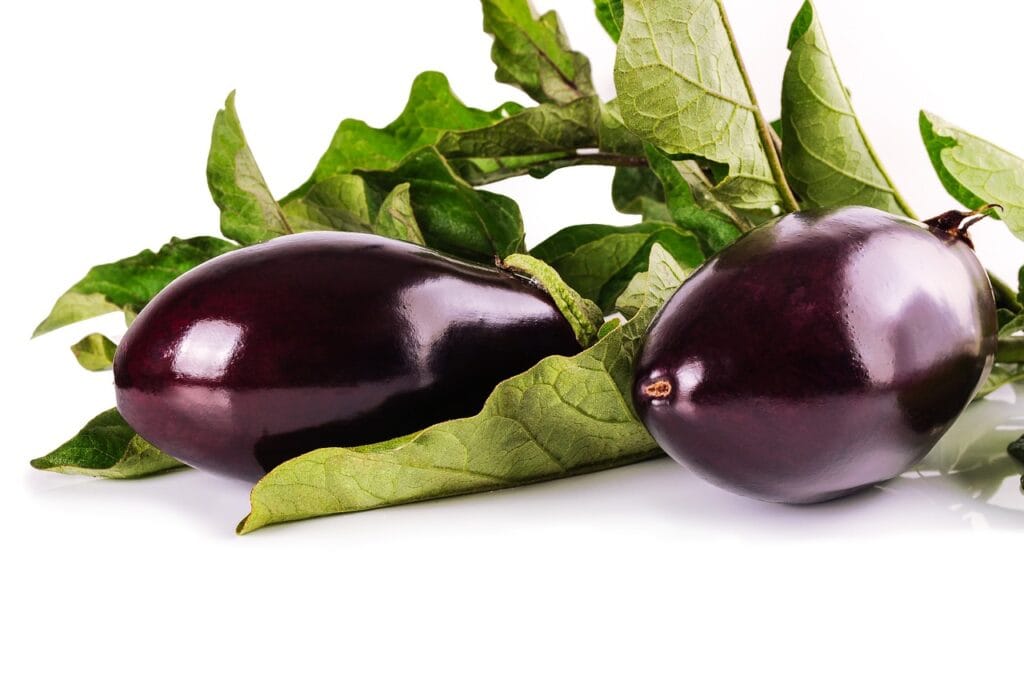Aubergines: (eggplants) The Versatile Violet Gem

Aubergines, with their glossy, deep purple skin and spongy flesh, are a culinary delight that adds a touch of elegance to any dish. Originating from India, these nightshade vegetables have traveled the globe, adapting to countless cuisines and captivating taste buds everywhere. Often mistaken for a simple vegetable, aubergines are botanically classified as berries, making them a fascinating addition to your garden.
Imagine harvesting your plump, vibrant aubergines, ready to be transformed into savory delights. From creamy baba ghanoush to hearty moussaka, the possibilities are endless. Whether you’re a seasoned gardener or a newbie, growing aubergines is a rewarding experience that brings beauty and deliciousness to your garden and table.
Why Grow Aubergines?
- Culinary Versatility: Aubergines absorb flavors beautifully, making them perfect for a wide range of dishes, from stir-fries to stews.
- Visual Appeal: Their vibrant purple, white, or even striped skin adds a splash of color to your garden and plate.
- Nutritional Benefits: Aubergines are a good source of fiber, vitamins, and antioxidants.
- Gardening Satisfaction: Watching these beautiful vegetables grow and harvesting them is incredibly rewarding.
- Variety of Cultivars: There are many aubergine varieties, from small and round to long and slender, allowing you to experiment with different flavors and textures.
- Great for Vegetarian and Vegan Dishes: Aubergines are a staple in many vegetarian and vegan cuisines, providing a hearty and satisfying base.
How to Eat Aubergines:
- Roasted: Roasting brings out the aubergine’s natural sweetness and creamy texture.
- Grilled: Grilling imparts a smoky flavor, perfect for summer barbecues.
- Stir-fried: Quick and easy, stir-frying keeps aubergines tender and flavorful.
- Baked: Baked aubergines can be stuffed with various fillings for a hearty meal.
- Fried: Thin slices of aubergine, lightly fried, are a delicious treat.
- Puréed: Aubergine purée is the base for dishes like baba ghanoush and can be added to soups and sauces.
Growing Aubergines:
Aubergines are warm-season annuals, which complete their life cycle in one growing season. They thrive in warm climates and require a long growing season, typically 70-90 days from transplanting.
- Planting: Start seeds indoors 8-10 weeks before the last frost date. Transplant seedlings outdoors when soil temperatures reach at least 60°F (15°C). Space plants 18-24 inches apart in rows 30-36 inches apart.
- Soil: Aubergines prefer well-drained, fertile soil with a pH between 6.0 and 6.8. Before planting, amend the soil with compost or well-rotted manure.
- Sunlight: They need at least 6-8 hours of direct sunlight daily.
- Watering: Keep the soil consistently moist, especially during flowering and fruiting. Water deeply at the base of the plant to avoid wetting the foliage.
- Fertilizing: Feed aubergines with a balanced fertilizer every 2-3 weeks during the growing season. A fertilizer higher in phosphorus will encourage flowering and fruiting.
- Support: As aubergines grow, they may need support to prevent the plants from toppling over. Use stakes or cages to support the plants.
- Temperature: Aubergines are sensitive to cold temperatures. Protect them from frost and provide warmth during cool nights.
Tips and Tricks:
- Pinching: Pinch off the first few flowers to encourage bushier growth and increase yield.
- Mulching: Mulch around the plants to retain moisture, suppress weeds, and regulate soil temperature.
- Pest Control: Watch for pests like aphids, flea beetles, and spider mites. Use organic pest control methods when necessary.
- Harvesting: Harvest aubergines when they are glossy and firm. Overripe aubergines can become bitter.
Aubergine Cuisine:
Aubergines are a staple in Mediterranean, Middle Eastern, and Asian cuisines. Here’s a simple recipe to get you started:
Roasted Aubergine with Garlic and Herbs:
- Ingredients:
- 2 medium aubergines
- 4 cloves garlic, minced
- 2 tablespoons olive oil
- 1 teaspoon dried oregano
- 1/2 teaspoon dried thyme
- Salt and pepper to taste
- Instructions:
- Preheat oven to 400°F (200°C).
- Cut aubergines into 1-inch cubes.
- In a bowl, toss aubergines with olive oil, garlic, oregano, thyme, salt, and pepper.
- Spread aubergines in a single layer on a baking sheet.
- Roast for 25-30 minutes, or until tender and golden brown.
Nutritional Value:
According to the USDA FoodData Central:
Nutritional value per 100g of raw aubergine:
- Calories: 25 kcal
- Total Fat: 0.18 g
- Saturated Fat: 0.008 g
- Cholesterol: 0 mg
- Sodium: 2 mg
- Total Carbohydrate: 5.88 g
- Dietary Fiber: 3 g
- Sugars: 3.53 g
- Protein: 0.98 g
- Potassium: 229 mg
- Vitamin C: 2.2 mg
Summary and Conclusion:
With their rich flavor and versatile nature, Aubergines are a fantastic addition to any garden and kitchen. Growing these beautiful vegetables is a rewarding experience that brings both visual appeal and culinary delight. You can enjoy a bountiful harvest of delicious aubergines with a little care and attention. From roasted to grilled, baked to stir-fried, the possibilities are endless. So, grab your gardening gloves and get ready to cultivate your own vibrant aubergines!
Disclaimer: This post is for informational purposes only and should not be construed as health, wellness or nutrition advice. Please see our full disclaimers here.
« Back to Glossary Index
